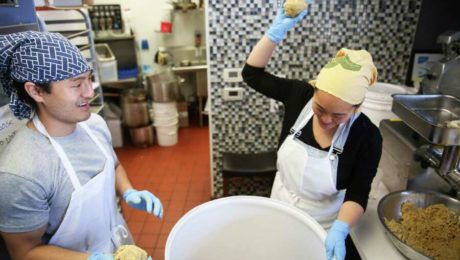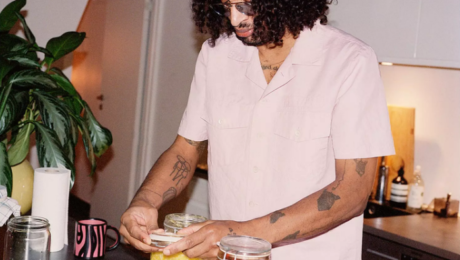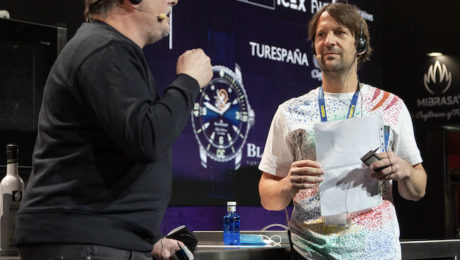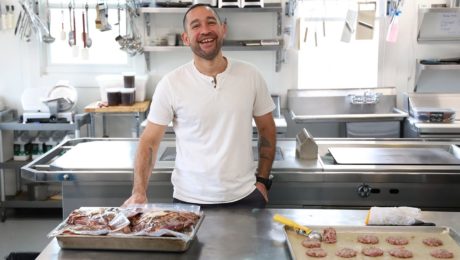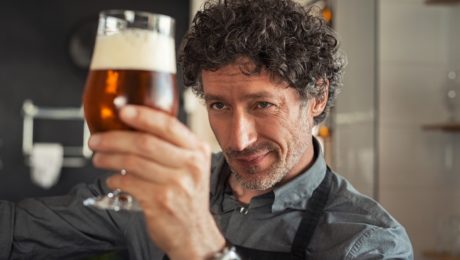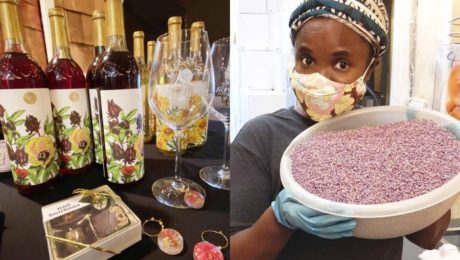Scaling Artisanal Fermentation
Fungi fermenter Shared Cultures was the featured cover story in a recent Food & Wine section of the San Francisco Chronicle. Company co-owners Elena Hsu and Kevin Gondo make small-batch fermented soy sauce, miso, and sauces and marinades using koji and wild, foraged mushrooms.
The article calls Shared Cultures “the darling of the Bay Area food scene.” It details how they use traditional techniques with unexpected ingredients, like a shoyu with quinoa and lentils, a miso with cacao nib and a koji salt with leek flowers.
Hsu and Gondo also open up about the challenges of scaling artisanal fermentation. They are the only employees at the companys and can’t keep up with the demand. Their ferments require a lot of time, some fermenting for eight months in a closet-size room in their rented commercial kitchen. They note that it is too expensive to rent or purchase their own warehouse in the Bay Area.
Multiple California chefs use Shared Cultures products for an added umami punch. Hsu encourages home cooks to experiment with their products, too, “You don’t have to have a $300 tasting menu to try these flavors,” she says. “You can be the chef.”
Read more (San Francisco Chronicle)
- Published in Business, Food & Flavor
Zilber: Fermentation’s Endless Potential
David Zilber says the potential for fermented food is endless. “There isn’t any sort of food that doesn’t benefit from some aspect of fermentation,” he said. “There’s really no limitation to its application.”
Zilber, the former head of the Noma fermentation lab, co-authored “The Noma Guide to Fermentation” with Noma founder Rene Redzepi. In the fall of 2020, Zilber surprised the food world when he left his job at Noma to join Chr. Hansen, a global supplier of bioscience ingredients.
He shared his insight on fermentation on The Food Institute Podcast. An Oxford study found over 30% of the world’s food has been touched by microbes. Zilber, a microbe champion, says one of the best parts of fermenting with plant-based ingredients is the microbes don’t need to change.
“We do need to find ways to adapt them to new sources, but there will always be a place within the pie chart of what humans are eating on earth for fermentation,” he says.
Part of Zilber’s work at Chr. Hansen is in the plant-based protein alternative segment, fermenting plant ingredients to “bring this other set of characteristics” to a new food item. He advises fermenters using plant-based ingredients to make their ingredient list concise and pronounceable to consumers.
“I am a huge proponent for formulating recipes from whole ingredients,” Zilber says. “Keeping the ingredient list short and concise and using natural processes to achieve flavor or textual properties … because it is the healthiest way to eat.”
Across the spectrum of fermentation, he feels fermented beverages is the category where he sees the greatest opportunity.
Read more (The Food Institute)
- Published in Food & Flavor
Redzepi on the Changing Fine Dining Industry
Expect more changes to fine dining as the restaurant industry grapples with Covid-19 changes, casual eateries adapt more fine dining techniques and the war in Ukraine continues to affect the world economy.
“Everyday restaurants have become so amazing. It’s not like it used to be, you used to go to the best restaurant to get the most tender piece of meat and the perfect ice cream,” says Rene Redzepi. He is the founder of Noma, the Michelin three-star restaurant in Copenhagen lauded as one of the top in the world. “You can find typical luxury ingredients like caviar and wagyu in airports. The quality of cooking now is so high.”
Redzepi spoke at Madrid Fusión, one of the largest and oldest international gastronomy conventions. Andoni Luis Aduriz, chef and owner of the renowned Spanish restaurant Mugaritz, spoke with Redzepi.
Redzepi says there’s been a “flavor spread” or “quality spread” of gastronomy techniques. He points to espumas, the Spanish term for culinary foaming. – now used on every continent, in every level of restaurant. A gourmet dish may come from the neighborhood brasserie, a tapas bar or even a food truck. It’s “dramatically changed” the restaurant industry, he notes.
“That’s because people don’t understand the influence and the philosophies that [are] now completely naturalized in every corner of gastronomy,” he says. Techniques once used only in premier establishments have become part of cooking DNA. “I hope fermentation will be that because I genuinely believe in the power of that.”
When Noma opened in November 2003, Redzepi promised Nordic cuisine made with local produce. But it was winter and freezing, making sourcing food a challenge, “so I stepped into the wilderness to find flavors.”
He also realized Noma needed to conserve summer produce for the long winter.
“We started to use pickling, fermentation, drying, smoking. Twenty years later, we have this bank of knowledge,” he said. “Before, we used to try 20,000 different fermentation techniques, now we are trying one at a time, with the whole team, like we are doing with lacto-fermentation.”
Fermentation drives an enormous amount of innovation at Noma. Redzepi told the Madrid Fusion audience that the restaurant industry is one of the most difficult to work in, so innovation and experience are what drive profitability.
“That’s what makes it special, putting together a team, while constantly looking for the ‘next big thing,’” he says. “That’s where the challenge is; pushing yourself outside of your comfort zone, until you have no clue what you’re doing, but as a group, you draw on your experiences, you trust each other, and you dare to move onwards.”
Redzepi praised the current state of Spain’s cuisine, saying “the Spanish influence is a natural part of any fine dining kitchen in the Western world.”When he was starting out in the 90s, French food was the only focus for chefs. “You were going to cook French food in Denmark, that’s what I always thought to myself.” But when he took a job cooking in Spain for a season, “it was like everything that you had been taught before, all your rules that you knew, were sort of thrown away and you could build and dream in a different way. “[Spanish cuisine] has given me the very seed of everything that’s become Noma.”
- Published in Food & Flavor
Growing the Hard Kombucha Category
Hard kombucha is one of the fastest growing alcohol categories. Could it become the next cider, craft beer or even hard seltzer?
“That’s the big question, isn’t it. It’s up to us to do it,” says Joshua Rood, CEO and managing director of Dr Hops hard kombucha. “If we could make it so good that beer people get excited about it and wine people get excited about it, well now there’s potential for something really, really big. That’s how craft beer did it — they focused so much on quality that they just blew regular beer out of the water on quality and everyone went for it because it was just so much better. We’re committed to what’s possible.”
Declared the “drink of summer” in both 2020 and 2021, hard kombucha continues to grow this year. While still only a small segment (~$58 million) of the overall alcoholic beverage market, hard kombucha’s dollar sales growth is big at 60%. And this performance is at a time when sales are declining for both cider and hard seltzer.
“Seltzer is really homogenous, there’s no differentiation for the most part, whereas kombucha, every brand is very different,” says Joe Carmichael, co-founder of Local Roots Kombucha. “A lot more than craft beer, there’s a lot you can do with it.”
The two spoke on a hard kombucha panel at KombuchaKon, joined byJames Conery, manager of innovation at Sierra Nevada Brewing Co., and Steve Dickman, owner and brewmaster of Rocky Mountain Cultures and High Country Kombucha. The brewers agreed: hard kombucha can become as great as the craft beer category.
“For us, fermentation is part of the process,” Rood says.”There are live lactobacillus cultures still alive up to 11% ABV [Dr Hops ABV]. We chose that [alcohol level] because, for us, it was an expression of craft. It was a great style.”
The acidity of kombucha masks the taste of alcohol, making hard kombucha a smoother, tangier drink. While beer is made from grain, hard kombucha is made from tea leaves. This gives it its “better-for-you” profile, drawing on the antioxidants, vitamins and minerals in tea.
Kombucha brewers hoping to add a hard kombucha line need to realize that it is a “totally different business than non-alcoholic,” Rood says. The regulations are strict.
“If you’ve never done an alcohol booch and you’re going to get into it, some of the things we’re going to touch on, like probiotics or health claims, the TTB (Alcohol and Tobacco Tax and Trade Bureau) has very big issues with health claims,” says Steve. “You cannot make health claims with alcohol. …There are a lot of regulations that come with it, a lot of ingredients you can’t use.”
Adds Conery, who runs the Strainge Beast brand for Sierra Nevada: “If you’re thinking about doing hard kombucha, you really need to research all the regulations before you start to do anything, before you even make it, so you know what you need to do.”
Even brewing hard kombucha is not without its challenges, too. Similar to beer, it requires the monitoring of key parameters — acidity, temperature, yeast strain, nutrients, time. But yeast is a delicate organism that can be difficult to manage, but which can alter the flavors of a brew.
Creating their first non-beer line came with growing pains for Sierra Nevada, one of the largest brewers in the U.S. Strainge Beast’s launch in 2020 required the company to make a substantial investment in its Chico, Calif., brewery, to seal off and isolate its beer operations from the hard kombucha line.
“As a brewer, I’ve spent my entire life making sure what kombucha is does not get into my brewery, because everything in kombucha is what you’d consider a beer spoilage organism,” Conery said. “We have to be very good about keeping what we’re doing with our kombucha segregated. As you scale up — especially with alcohol — there are a lot of things that can go wrong.”
Working with yeast is always a growing experience, “I’m still in the trial and error process,” Conery said. It took Sierra Nevada “quite a long time to find the correct yeast strain when we were fermenting to make our alcohol.” Yeast can create unique flavors — or funky, bad-tasting brews. A brewery will spend months exploring what yeast they want to use.
“It is the most interesting and horrible part of the production side, which is how to get the flavors you want, effectively,” Rood said. “When you’re dealing with a very acidic environment, that’s one of the biggest challenges and you want that acidity, which is part of the challenge. But you want your yeast to do a good, clean, healthy job of fermenting the alcohol.”
While both Sierra Nevada and Dr Hops approached hard kombucha with backgrounds in craft beer, Dickman at High Country Kombucha came from the kombucha world.When making hard kombucha, he brews the kombucha flavor he wants, then creates a neutral seltzer-like base. He blends the two together for the ABV value he desires, and says he likes this method as a way to experiment with acidity profiles.
“Kombucha was always a cool beverage, but now it’s bringing the party,” Dickman said.
- Published in Food & Flavor
Zero Waste with Fermentation Techniques
Paste Magazine highlights the fermentation philosophy of Chef David Porras, who operates the Oak Hill Café and Farm. The hyper-local site, a 2020 James Beard semi-finalist for Best New Restaurant, operates in Greenville, South Carolina, on a 2.4-acre farm.
Porras’ kitchen, according to the magazine, “looks like an alchemist’s workroom, jars and tubs of experimental pickling, emulsions and infusions dotting the counter.”
“I was always interested in learning about fermentation. Fermentation is a flavor — you can use it for cooking just like lime or lemon juice,” he said.
The restaurant’s menu reflects a true farm-to-table approach. They use permaculture (sustainable agriculture planning to mimic nature) to keep the farm at peak fertility to grow healthy produce. By fermenting instead of trashing unused food, they’ve reduced 50% of their food waste.
“We try to be zero waste by applying fermentation techniques as well as drying, infusion, teas, powders and compost tea,” he said.
Read more (Paste Magazine)
- Published in Food & Flavor
The Ancient Origins of Japanese Soy Sauce
Soy sauce is arguably the most important seasoning in Japanese cooking. Its well-balanced, salty-sweet taste and deep layer of umami richness make nearly all foods taste more delicious and satisfying. Its uses range from a dab on sushi to a splash into noodle soups and stir-fries, as well as the featured flavor of glazed dishes like teriyaki,” reads an article in BBC Travel.
The author traveled to the port town of Yuasa to learn more about the history of the “holy grail of Japanese cuisine: soy sauce.” In 2017, the country’s Agency for Cultural Affairs designated Yuasa as a Japan Heritage Site for being the birthplace of Japanese soy sauce. Soy sauce was first made in Yuasa in the 13th Century.
At its peak, the small town with a population of around 1,000 had more than 90 soy sauce breweries. Today, there are five soy sauce shops and six Kinzanji-miso makers. The decline is related to the rise of mass-produced soy sauce brands, who skimp on quality for a lower-priced soy sauce. It’s estimated that only 1% of soy sauce brewers still produce using traditional methods.
Read more (BBC)
- Published in Food & Flavor
Mastering Indoor Mushroom Farming
After four decades of research, brothers from Copenhagen have developed a method to reliably cultivate morel mushrooms indoors, year-round, in a climate-controlled environment. Morels typically grow for only a few months in the spring in finicky, woodland locations. They also sell for a high price.
Jacob and Karsten Kirk, 64-year-old twins, yielded 20 pounds per square yard of morels in last year’s crop. Karsten said: “the cost per square meter for producing a morel will be roughly the same as producing a white button mushroom.” They call their efforts the Danish Morel Project and they’re still figuring out how to commercialize it.
Kenneth Toft-Hansen, a Danish chef and winner of the 2019 Bocuse d’Or, notes if the Kirk brothers are able to master sourcing morels widely and affordably, “it will be a game changer for the food industry.”
Read more (The New York Times)
- Published in Food & Flavor
Color of Food Culture
The United States is becoming more diverse, with 4 of every 10 Americans identifying as non-white. But grocery stores have been a poor reflection of that mix of cultures. Now, a group of BIPOC food entrepreneurs are encouraging buyers and retailers to expand the range of products featured on store shelves.
“It has to start with leadership at the top saying, ‘We have to champion emerging brands because it’s good business,’” says Clara Paye, founder of UNiTE Foods, a maker of protein bars with international flavors. “Let’s face it. Your customers are diverse. They’re looking for diverse products. Create the incentive structures for buyers out there to have those placements and do it confidently.”
Paye was part of a panel at Natural Products Expo West discussing the challenges and opportunities for founders of color. The U.S. food system, the panelists lamented, is far from equitable. For example, though foods like kimchi and miso are staples in Asian countries, shoppers are hard-pressed to find a broad and deep array of multicultural food products at a typical American grocery.
“There wasn’t an avenue if you weren’t born and raised in America,” Paye explains.
Reclaiming Food Culture
The panel stressed that they could never find the traditional foods they ate growing up when they went to American grocery stores. First- and second-generation immigrants have never been the focus of major retail food brands. Underserved in this way, these BIPOC founders say they started their companies to reconnect with the flavors of their cultures.
“We felt it was a travesty that the second largest continent in the world [Africa] didn’t have any reflection in mainstream grocery,” says Perteet Spencer, founder of Ayo Foods, which sells West African frozen dishes and jarred sauces. (Spencer — a former employee of SPINS, a retail sales data provider for natural products — spoke at a TFA webinar in 2021).
But she notes the food system is changing: “It’s clear that the market has shifted over the last several years and is embracing global flavors.”
Expanding the flavor of Mexican cuisine is the goal of Miguel Leal, co-founder and CEO of Somos, maker of Mexican meal kits.
“There’s stereotypically this (belief) that ethnic food has to be cheap,” he says. “It can be beautiful or clean or premium.”
Vanessa Pham agrees, adding there’s a narrative that authentic ethnic food should only be served in hole-in-the-wall restaurants. Pham is co-founder of Omsom, which makes chef-created Asian dishes. “Authentic” is a complicated term, she says.
“Authenticity sometimes pegs and limits food founders and chefs to a nostalgic idea, ‘How my grandma made it’ or ‘The traditional way,’” she explains. “We believe BIPOC chefs should be able to innovate. Cultural integrity is much more about doing your research, involving the right people and compensating ethically.”
Ethnic Aisle: Integrate or Celebrate?
The ethnic aisle in groceries is a debated topic among BIPOC food leaders. Some say it’s an easy way for shoppers to find international products; others argue it’s an antiquated and offensive placement.
“I like the ethnic aisle, I just don’t like the way it’s showing us today,” Leal says. “It’s a little bit of a caricature.”
A recent survey by Adobe found 66% of African Americans and 53% of Latinos feel their ethnicity is portrayed stereotypically in food advertisements.
Pham views a future where the hodgepodge of products in the ethnic aisle disappears, and rice noodles are sold next to spaghetti. Paye agrees. “I think it will be a thing of the past, a funny thing where we put candles and beans and matzo balls.”.
- Published in Business, Food & Flavor
Tastier Non-Alcoholic Beer
Though non-alcoholic drinks are growing in popularity, alcohol-free beer has been a laggard. These brews lack the flavorful aroma of hops, with the resulting beverage flat and watery.
Mimicking beer’s flavor profile has been challenging for brewers hoping to appeal to dry drinkers. Some producers add aroma hops in the final stages of brewing, but it’s expensive and wasteful.
“When you remove the alcohol from the beer, for example by heating it up, you also kill the aroma that comes from hops. Other methods for making alcohol-free beer by minimizing fermentation also lead to poor aroma because alcohol is needed for hops to pass their unique flavor to the beer,” says Sotirios Kampranis, a professor in University of Copenhagen’s department of plant and environmental sciences who led the research.
Now researchers from the university have found a possible solution. Their innovation uses baker’s yeast that’s grown in fermenters and releases an aroma of hops. Results of their study were published in the journal Nature.
“After years of research, we have found a way to produce a group of small molecules called monoterpenoids, which provide the hoppy-flavor, and then add them to the beer at the end of the brewing process to give it back its lost flavor. No one has been able to do this before, so it’s a game changer for non-alcoholic beer,” Kamprani says. “When the hop aroma molecules are released from yeast, we collect them and put them into the beer, giving back the taste of regular beer that so many of us know and love. It actually makes the use of aroma hops in brewing redundant, because we only need the molecules passing on the scent and flavor and not the actual hops,” explains Kampranis.
Sustainable Solution
Their discovery represents a potential breakthrough for the overall beer industry because, researchers point out, it could improve beer’s sustainability.
Aroma hops require an enormous amount of water. Over 713 gallons are needed to grow one kilogram of hops. And sourcing fresh hops involves a carbon-heavy supply chain. Hops are farmed mainly on the U.S. West Coast, so trucks and refrigeration units are needed for transportation .
By using baker’s yeast, researchers can create a hoppy flavor without wasting gallons of water and creating carbon emissions.
“With our method, we skip aroma hops altogether and thereby also the water and the transportation. This means that one kilogram of hops aroma can be produced with more than 10.000 times less water and more than 100 times less CO2,” Kampranis says. “Long term, we hope to change the brewing industry with our method – also the production of regular beer, where the use of aroma hops is also very wasteful.”
Kampranis and colleague Simon Dusséaux plan to have the process ready for the brewing industry by this October. The two have founded the biotech company EvodiaBio.
- Published in Food & Flavor, Science
An Overlooked Wine Category
“Aaliyah Nitoto, winemaker at Free Range Flower Winery, is tired of hearing that the category of wine is exclusive to grapes. For centuries, wine has been made from many kinds of plant products, she says, like grapes, apples, pears, rice and flowers,” reads an article in Wine Enthusiast.
The magazine highlights the history of flower wine, which has variations in the Middle East, Asia, Europe and even the U.S. The process to make the wine is different from a traditional grape wine. Fresh or dried flowers are boiled and crushed, then yeast and a sugar source are added to start the fermentation process.
Flower winemakers lament that their product is not respected in the wine industry. Flower wine has been made primarily by middle- to lower-income women.
“That can tell you right there why they were relegated to obscurity. The people who owned tracts of lands that had money and influence and got to name things like ‘noble grapes,’ they got to say what was wine and what wasn’t,” Nitoto (pictured) adds. “The opinion of people in this country over the last 100-odd years to try to get rid of this category doesn’t stand up to the history of winemaking, which is thousands of years old, which does call this wine.”
Read more (Wine Enthusiast)
- Published in Food & Flavor

